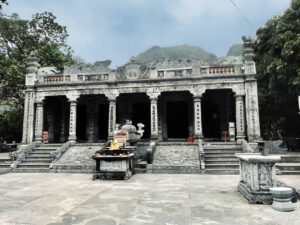Thái Vi and Cửa Quán temples are famous sacred temples popular with both residents and international visitors alike. With beautiful scenery, tranquil settings and a history spanning close to a millennium, Thai Vi also played an important role in defense of the Vietnam’s independence. It truly has been a ”living witness” to the evolution of the Vietnamese nation.
Located within the Tam Coc complex, there are two main options to reach it. The first and easiest way is to head to the main Van Lam wharf and take a Tam Coc – Thai Vi temple – Thien Huong boat tour. This takes around 2 hours and the boat will drop you near the site. From there it is a short walk to the temple itself.
However, a strong recommendation is to walk the kilometer of so from the Tam Coc boat station. Turn right when you come to the Cửa Quán temple and Thai Vi is around 500m further along. This route includes a stunning walk through rice fields surrounded by the iconic karst outcrops the district is famous for. You are also completing an important cultural ritual that is part of a traditional visit to Thai Vi.
Note
Legend has it to enter this important Regal temple, it was required to first report to the guards at Cua Quan temple to give advanced notice of your intentions. So if you take the Cua Quan route, be assured you are walking in the footsteps of history!
Thai Vi Temple
The Thai Vi Temple was built and consecrated by the first king of the Tran Dynasty – King Tran Thai Tong ( 1218-1277) . According to legend, after his victory over the Yuan (Mongol) Dynasty in 1258, King Tran Thai Tong decided to build a temple to celebrate and give thanks. Twice rejecting places not suitable due to feng shui, Thai Vi finally satisfied his criteria of ”Quần Sơn Hội Tụ”, a phrase describing a beautiful place surrounded by mountains and pure blue sky. Still a very apt description of Thai Vi on a clear day.
Modern Vietnamese feng shui masters agree the King was correct in his calculations and Thai VI is extremely suitable as a place of prayer, meditation and thanksgiving. Locally, the path leading from Cửa Quán temple is likened to a dragon’s body while Thai Vi Temple represents the dragon’s head. At the entrance to the cave and looking out over the Ngo Dong river are two large stone elephant statues, representing the war elephants extensively in the battles against the Mongol invaders, even the King himself riding one into battle.
Architecture
Thai Vi uses the triple arch entrance gate of traditional Vietnamese architecture, signifying the ”three ways of seeing” Buddhism. A pair of moss covered stone horses stand at the sides of the gate. Like the stone Elephants, these serve as guards to the temple and also in respect to their importance in transportation during times of both peace and war.
An important note is that the entire structure was built using local stone and wood. Heavily etched in motifs and carvings by ancient master craftsmen, the building is a testament to local industriousness. Entering the main gate, in the front yard are two small green ponds for breeding koi.
The Bell Towers
There are two bell towers, one containing a bronze bell cast in 1600s while in the other is a traditional drum stand. Both used to “calm the mind” but also in warning during times of trouble, and in ceremonies to ward off evil spirits. The nearby small “houses” are to prepare the ”votive papers”, the colorful paper “gifts” burnt as offerings for Vietnamese ancestors. At the end of the path is the main stone temple itself.
The architecture is designed to reflect symmetry, reverence and beauty, both for the glory of God and for worshipers who come to pay respect. The Tran Dynasty is renown as one of enlightenment that helped build the foundations of independence, self-reliance and resilience of the modern Vietnamese nation.
An incense burner in front of the door to the main hall frames several altars for worshiping several famous Tran Dynasty generals. In pride of place is the altar to King Tran’s grandson, the Buddhist King Trần Nhân Tông (1258 – 1308) who is considered the most influential Buddhist King in Vietnamese history.
On the high rafters hangs a Horizontal lacquered board engraved with Chinese characters and pillars decorated in flying dragons and clouds. On both sides are wooden swords, spears, hammers, all symbols of the weapons used to fight the hated Yuan invaders.
Kings and Queens
At the back of the main temple is a statue of King Tran Thai Tong, his queen and their son. As mentioned, King Tran Thanh Tong was an enlightened, much loved ruler and instrumental in building Hành Cung Vũ Lâm (Vu Lam palace). Above the altar are the tablets of the ancestors of the Tran family while at the side of the good king and his queen are the Senior Generals of the Dynasty, Prince Chiêu Minh Trần Quang Khải (1241–1294) and Lord Prince Trần Hưng Đạo (1228–1300), later known Saint Trần. Both were key commanders of the Dai Viet army who worked with the emperors of the Tran Dynasty to defeat the troops of Prince Toghon, Kublai Khan’s son.
The stone pedestals and altars for are carved with the four great mascots of Vietnamese culture: the dragon, unicorn, turtle and phoenix. Respectively, these four mascots symbolize power, wisdom, longevity, and immortality.
Mahayana Tower
At the temple’s rear area is a small tower in the style of Mahayana Buddhist architecture, with rock tables and chairs for visitors to sit and rest. The tiled spaces define an inner “fence” for visitors while the nearby carved stone turtles are engraved with the names of those who donated to preserve the temple. The temple has undergone many renovations and refurbishments, most notably in 1589, 1601, 1881, 1893, 1925. The most recent renovations are from 2006 to 2018, when the exterior structures were repaired but main temple itself left intact.
United Holy Land
Chu Văn Thim, aged 90 and the current curator of the temple says the Tran Dynasty wanted to pass it on to posterity as “A Sacred Land with Extraordinary People” and so engraved the outside temple poles with “Thảo Tú Sơn Lâm Vô Song Thánh Địa “, roughly translating as the “United Holy Land”.
On the 15th day of the third lunar month and after defeating the foreign invaders, the Tran king held a victory celebration. To this day the Thai Vi temple Festival continues the tradition from the 14th to the 17th day of the third lunar month (approximately mid-March in the Gregorian calendar). The festival celebrates a great victory and so is a lot of fun, with a dragon-lion dance, wrestling and a boat race. Not to be missed if you are in Ninh Binh during the Lunar March.
Thien Huong cave – Thai Vi temple – Cửa Quán temple are an important and beautiful part of Vietnamese history and a journey you should not miss when coming to Tam Coc. As all are national historical sites, entry is free though visitors are welcome to donate via the small collection boxes scattered about the temples. The temple also has gone digital, with cameras to monitor visitors’ vehicle in the Parking area but as always, especially during festival times, you may need to pay a small fee to ensure the safety of your vehicle.





